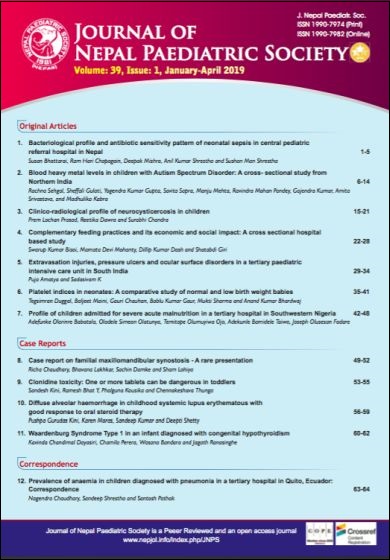Blood Heavy Metal Levels in Children with Autism Spectrum Disorder: A Cross- Sectional Study From Northern India
DOI:
https://doi.org/10.3126/jnps.v39i1.19905Keywords:
ASD, heavy metals, ICP-AES, lead, mercuryAbstract
Introduction: The role of heavy metals in the etio-pathogenesis of ASD is controversial. Paucity of studies from Indian subcontinent with different sociocultural and environmental background prompted the present study.
Methods: Sixty children aged three to 12 years with Autism Spectrum Disorder (ASD) and 60 age matched controls were enrolled. Detailed history including possible exposure history to various heavy metals was taken. Severity of ASD was assessed using Childhood Autism Rating Scale 2. Blood level of metals was estimated by Inductively coupled plasma - atomic emission spectroscopy (ICP-AES).
Results: Mean blood mercury levels in the two groups of ASD and controls was comparable (p = 0.28). Median blood cadmium and arsenic levels were higher in controls possibly due to higher ground water use and insecticide exposure. (7/60 versus 17/60, p = 0.04) and (2/60 versus 7/60, p = 0.08) while mean blood zinc level was lower in controls. Lead was significantly higher in greater proportion of children with ASD. (11/60 vs 1/60, p = 0.002). Children with ASD had significantly higher pica (26/60 versus 10/60, p = 0.001) and higher median number of days of antibiotics during infancy (24.5 (0-120) versus 15 (0-60), p = 0.004). None of the heavy metal tested had significant correlation with the severity of ASD.
Conclusions: Mean blood mercury, lead, zinc, arsenic and cadmium did not show significant association with diagnosis of ASD. High levels of toxic metals in both children with ASD and controls points towards an urgent need to contain environmental pollution by heavy metals.
Downloads
Downloads
Published
How to Cite
Issue
Section
License
Authors who publish with this journal agree to the following terms:
Authors retain copyright and grant the journal right of first publication with the work simultaneously licensed under a Creative Commons Attribution License that allows others to share the work with an acknowledgement of the work's authorship and initial publication in this journal.
Authors are able to enter into separate, additional contractual arrangements for the non-exclusive distribution of the journal's published version of the work (e.g., post it to an institutional repository or publish it in a book), with an acknowledgement of its initial publication in this journal.
Authors are permitted and encouraged to post their work online (e.g., in institutional repositories or on their website) prior to and during the submission process, as it can lead to productive exchanges, as well as earlier and greater citation of published work (See The Effect of Open Access).



